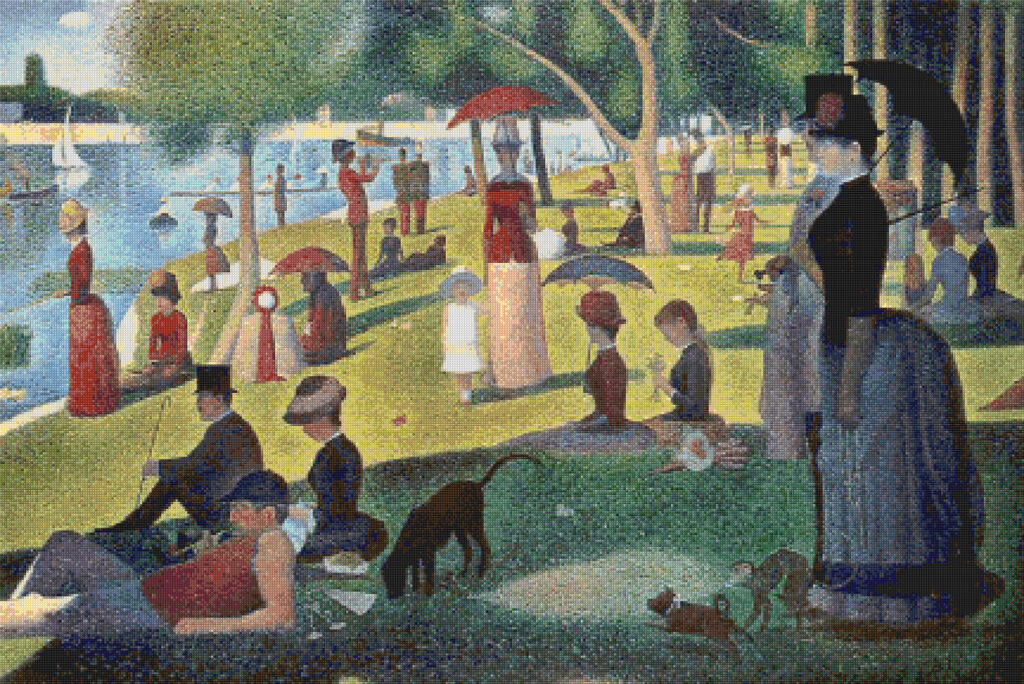Art, History, and the Story Behind Seurat’s Masterpiece

Step back to a sunny afternoon in 1880s Paris, where leisure meets innovation on the banks of the River Seine. Georges Seurat’s masterpiece, A Sunday Afternoon on the Island of La Grande Jatte, invites viewers into a calm yet vibrant world of color, science, and social evolution. But how did Seurat’s work, and his pioneering technique of Pointillism, make such an impact? Join us as we explore the history, artistry, and meaning behind this iconic painting.
1. The Artist and His Vision: Georges Seurat
Georges Seurat, a young and ambitious painter, was a leading figure of the Post-Impressionist movement. Born in 1859, he sought to innovate beyond Impressionism’s loose, expressive brushstrokes by introducing a more scientific approach to color. His technique, which he called “Pointillism,” was based on the belief that small, distinct dots of color, when placed side by side, would blend naturally in the viewer’s eye to create a fuller, more vibrant image.
When Seurat started A Sunday Afternoon on the Island of La Grande Jatte in 1884, he was only 25 years old. This ambitious project took him over two years to complete, during which he conducted studies and sketches to perfect the composition.
2. What is Pointillism?
Pointillism is the technique Seurat developed by meticulously applying tiny dots of unmixed color to the canvas. Unlike traditional methods, where colors were blended on a palette, Seurat’s colors would blend visually. Inspired by scientific color theories, he used complementary colors—like blue and orange or red and green—to create contrast and vibrancy.
Each dot of paint in La Grande Jatte contributes to a larger mosaic-like effect. The technique required incredible patience, but Seurat believed it would bring out a brighter, more lifelike appearance. Cross-stitchers might relate to Pointillism: every stitch (or “dot”) plays a role in the final image, contributing to a masterpiece when viewed as a whole.
3. Setting the Scene: Life on the Seine
The painting depicts a typical Sunday afternoon on Île de la Grande Jatte, an island in the River Seine where Parisians from all walks of life came to relax. With industrialization and the advent of the weekend, city dwellers had more leisure time, and parks became popular destinations for relaxation and socializing. This work captures the spirit of the era, showing people of various backgrounds together in a public space—a novel idea at the time.
Seurat included over 40 figures in his composition, each posed in an almost statue-like manner. This “frozen” quality of the figures has intrigued art historians, as it suggests a sense of stillness or perhaps a commentary on the formal social structures of the time.
4. Symbolic Details and Hidden Meanings
Seurat was known for his attention to detail, and many elements in La Grande Jatte contain subtle symbolism:
- The Monkey: A small monkey on a leash, held by a woman in the foreground, could symbolize promiscuity, hinting at the playful or even flirtatious nature of leisure culture.
- The Fishing Pole: Another woman nearby is holding a fishing pole, a symbol often associated with “fishing for a partner” in art.
- Fashion and Class: The variety of clothing, from elegant dresses to top hats, shows the social diversity of Parisian life, with people of all classes represented together—a somewhat progressive notion in Seurat’s day.
These elements, along with the setting itself, offer a snapshot of Parisian life in the 1880s, inviting viewers to observe and ponder the interactions of different social groups.
5. Legacy and Influence of La Grande Jatte
Seurat’s work initially puzzled critics, who were unfamiliar with such a precise, scientific approach to painting. But as the years passed, his method of Pointillism and the composition of La Grande Jatte were celebrated for their innovation and beauty. This painting influenced numerous artists, including Paul Signac and the future Cubists, who appreciated its structure and method.
Today, A Sunday Afternoon on the Island of La Grande Jatte is one of the most recognized pieces of French art, displayed prominently at the Art Institute of Chicago. It has inspired countless adaptations and references in popular culture, from literature and film to theater.
Cross-Stitching a Piece of History
By cross-stitching La Grande Jatte, you’re not just creating a piece of art; you’re connecting to Seurat’s groundbreaking work and the rich cultural history it represents. Imagine each stitch as one of Seurat’s dots, a small yet essential part of a larger vision, bringing Parisian leisure and 19th-century innovation to life on your own canvas.
Whether you’re new to art history or a seasoned enthusiast, this piece offers a unique way to enjoy and celebrate a timeless masterpiece.
Ready to start your own “painted tapestry”?
Discover the A Sunday Afternoon on the Island of La Grande Jatte cross-stitch pattern [link to product page].
